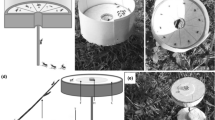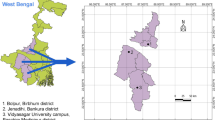Abstract
Stingless bees are highly social pollinators in tropical ecosystems. Besides floral pollen and nectar, they collect substantial amounts of plant resins, which are used for nest construction/maintenance and defence against antagonists. Moreover, some stingless bees extract chemical compounds from resins and incorporate them in their cuticular chemical profiles, rendering this trait directly dependent on the plant community of the surrounding environment. While previous studies have investigated how variation in the composition and diversity of available resin sources affect resin storages inside hives, subsequent effects on the bees’ cuticular chemistry have not been studied. To fill this gap, we investigated the number, proportion and composition of compounds in the cuticular chemical profile of an Australian stingless bee using gas chromatography and mass spectrometry. We analysed whether and (if so) how the cuticular chemistry was affected by habitat (i.e., plantations, forests, and gardens) and tree species richness. We found that overall numbers and proportions of self-produced and resin-derived compounds in the cuticular chemical profiles of Tetragonula carbonaria were similar across habitats, while the composition of all compounds (i.e., both self-produced and resin-derived) and of resin-derived compounds differed between habitats. This indicates that the surrounding tree species community and thus available resin chemistry affected the composition of particularly resin-derived compounds on the bees’ cuticle. As the number and composition of resin-derived cuticular compounds were not affected by tree species richness, stingless bees appear to selectively incorporate specific compounds available in the surrounding environment in their cuticular chemical profiles, which may increase their defensive properties.

Similar content being viewed by others
References
Baldock KC et al (2015) Where is the UK’s pollinator biodiversity? The importance of urban areas for flower-visiting insects. Proc R Soc B 282:20142849
Blomquist GJ, Bagnères A-G (2010) Insect hydrocarbons: biology, biochemistry, and chemical ecology. Cambridge University Press, Cambridge
Castaldo S, Capasso F (2002) Propolis, an old remedy used in modern medicine. Fitoterapia 73:S1–S6
Cheng AX, Lou YG, Mao YB, Lu S, Wang LJ, Chen XY (2007) Plant terpenoids: biosynthesis and ecological functions. J Integr Plant Biol 49:179–186
Dollin AE, Dollin LJ (1997) Australian stingless bees of the genus Trigona (Hymenoptera: Apidae). Invertebr Syst 11:861–896
Drescher N, Wallace HM, Katouli M, Massaro CF, Leonhardt SD (2014) Diversity matters: how bees benefit from different resin sources. Oecologia 176:943–953
Espelie KE, Gamboa GJ, Grudzien TA, Bura EA (1994) Cuticular hydrocarbons of the paper wasp, Polistes fuscatus: a search for recognition pheromones. J Chem Ecol 20:1677–1687
Fröhlich B, Tautz J, Riederer M (2000) Chemometric classification of comb and cuticular waxes of the honeybee Apis mellifera carnica. J Chem Ecol 26:123–137
Greenleaf SS, Williams NM, Winfree R, Kremen C (2007) Bee foraging ranges and their relationship to body size. Oecologia 153:589–596. https://doi.org/10.1007/s00442-007-0752-9
Heard TA (1994) Behaviour and pollinator efficiency of stingless bees and honey bees on macadamia flowers. J Apic Res 33:191–198
Kaluza BF, Wallace H, Heard TA, Klein AM, Leonhardt SD (2016) Urban gardens promote bee foraging over natural habitats and plantations. Ecol Evol 6:1304–1316
Kaluza BF et al (2017) Generalist social bees maximize diversity intake in plant species rich and resource abundant environments. Ecosphere 8:e01758
Lehmberg L, Dworschak K, Blüthgen N (2008) Defensive behavior and chemical deterrence against ants in the stingless bee genus Trigona (Apidae, Meliponini). J Apic Res 47:17–21
Leonhardt SD, Blüthgen N (2009) A sticky affair: resin collection by Bornean stingless bees. Biotropica 41:730–736
Leonhardt S, Blüthgen N, Schmitt T (2009) Smelling like resin: terpenoids account for species-specific cuticular profiles in Southeast-Asian stingless bees. Insectes Soc 56:157–170
Leonhardt SD, Jung L-M, Schmitt T, Blüthgen N (2010) Terpenoids tame aggressors: role of chemicals in stingless bee communal nesting. Behav Ecol Sociobiol 64:1415–1423
Leonhardt SD, Blüthgen N, Schmitt T (2011a) Chemical profiles of body surfaces and nests from six Bornean stingless bee species. J Chem Ecol 37:98–104
Leonhardt SD, Schmitt T, Blüthgen N (2011b) Tree resin composition, collection behavior and selective filters shape chemical profiles of tropical bees (Apidae: Meliponini). PLoS ONE 6:e23445
Leonhardt SD, Wallace HM, Schmitt T (2011c) The cuticular profiles of Australian stingless bees are shaped by resin of the eucalypt tree Corymbia torelliana. Aust Ecol 36:537–543
Leonhardt SD, Rasmussen C, Schmitt T (2013) Genes versus environment: geography and phylogenetic relationships shape the chemical profiles of stingless bees on a global scale. Proc R Soc B 280:20130680
Leonhardt SD, Wallace HM, Blüthgen N, Wenzel F (2015) Potential role of environmentally derived cuticular compounds in stingless bees. Chemoecology 25:159–167
Litman JR, Danforth BN, Eardley CD, Praz CJ (2011) Why do leafcutter bees cut leaves? New insights into the early evolution of bees. Proc R Soc B 278:3593–3600
Loram A, Thompson K, Warren PH, Gaston KJ (2008) Urban domestic gardens (XII): the richness and composition of the flora in five UK cities. J Veg Sci 19:321–330
Massaro C et al (2014) Anti-staphylococcal activity of C-methyl flavanones from propolis of Australian stingless bees (Tetragonula carbonaria) and fruit resins of Corymbia torelliana (Myrtaceae). Fitoterapia 95:247–257
Michener CD (2007) The bees of the world. Johns Hopkins University Press, Baltimore
Oksanen J et al (2015) Vegan: community ecology package. R package version 2.2-1
Pinheiro J, Bates D, DebRoy S (2018) Nlme: linear and nonlinear mixed effects models R package version 31-137
R Core Team (2015) R: A language and environment for statistical computing. Vienna, Austria; 2014
Roubik DW (1992) Ecology and natural history of tropical bees. Cambridge University Press, Cambridge
Roubik DW (2006) Stingless bee nesting biology. Apidologie 37:124
Slaa EJ, Chaves LS, Malagodi-Braga KS, Hofstede FE (2006) Stingless bees in applied pollination: practice and perspectives. Apidologie 37:293
Smith R-K, Taylor OR Jr (1990) Unsaturated extracted hydrocarbon caste differences between European queen and worker honey bees, Apis mellifera L.(Hymenoptera: Apidae). J Kans Entomol Soc 63:369–374
Smith JP, Heard TA, Beekman M, Gloag R (2017) Flight range of the Australian stingless bee Tetragonula carbonaria (Hymenoptera: Apidae). Austral Entomol 56:50–53
Vit P, Pedro SR, Roubik D (2013) Pot-honey: a legacy of stingless bees. Springer, New York
Vithanage V, Ironside D (1986) The insect pollinators of macadamia and their relative importance. J Aust Inst Agric Sci 52:155–160
Wallace HM, Lee DJ (2010) Resin-foraging by colonies of Trigona sapiens and T. hockingsi (Hymenoptera: Apidae, Meliponini) and consequent seed dispersal of Corymbia torelliana (Myrtaceae). Apidologie 41:428–435
Wallace H, Trueman S (1995) Dispersal of Eucalyptus torelliana seeds by the resin-collecting stingless bee, Trigona carbonaria. Oecologia 104:12–16
Acknowledgements
We thank Tim Heard for providing the Tetragonula carbonaria colonies and Sahara Farms, Macadamia Farm Management Pty Ltd and Maroochy Bushland Botanic Gardens, as well as numerous private land and garden owners for hosting our colonies. We are further grateful for the constructive comments provided by two anonymous reviewers, which greatly helped in shaping the presentation of this study. BFK received funding from the German Academic Exchange Agency (DAAD). Funding was provided by the Deutsche Forschungsgemeinschaft (DFG project: LE 2750/1-1).
Author information
Authors and Affiliations
Corresponding author
Additional information
Handling Editor: Gunther Raspotnig.
Rights and permissions
About this article
Cite this article
Kämper, W., Kaluza, B.F., Wallace, H. et al. Habitats shape the cuticular chemical profiles of stingless bees. Chemoecology 29, 125–133 (2019). https://doi.org/10.1007/s00049-019-00282-4
Received:
Accepted:
Published:
Issue Date:
DOI: https://doi.org/10.1007/s00049-019-00282-4




